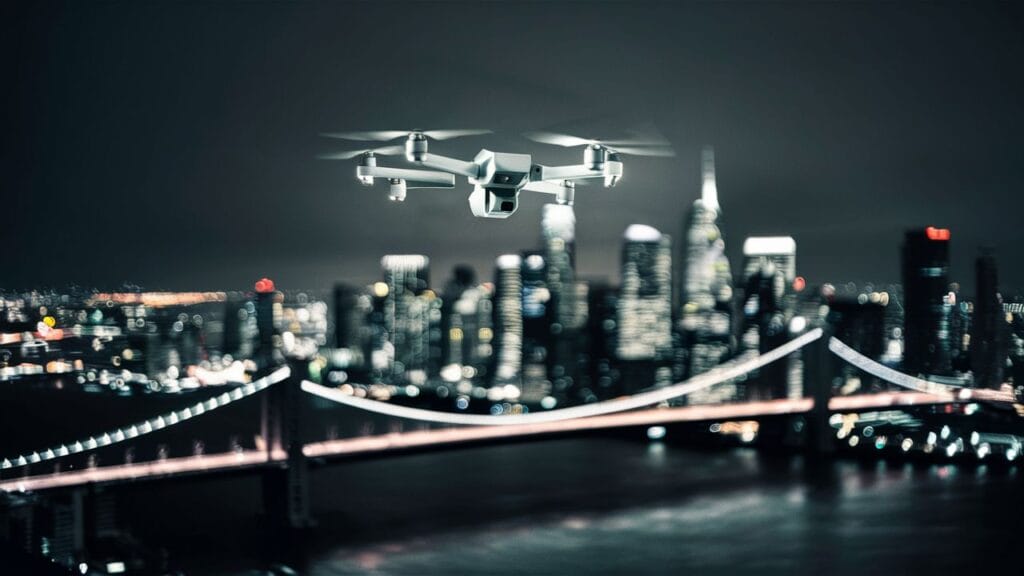You must have encountered this questoion that can drones fly at night? This blog post delves into the regulations, challenges, and technologies that enable or restrict drone flying at night. From legal considerations to technical requirements, understanding the nuances of nighttime drone flights is crucial for enthusiasts and professionals. Stay tuned to explore the possibilities and limitations of flying drones in low-light conditions.

Night Drone Flying Basics
Lighting Considerations
When flying drones at night, proper lighting is crucial for maintaining visibility and ensuring safe operations. Inadequate lighting can lead to accidents and loss of control over the drone.
Challenges and Considerations
One key challenge of night drone flying is the reduced visibility, making it harder to navigate obstacles and maintain situational awareness. Limited natural light can also affect camera performance and overall flight experience.
Night flights require compliance with regulations regarding lighting requirements for unmanned aircraft. Pilots must ensure their drones have visible strobes or lights to enhance visibility for other aircraft and prevent collisions.
Benefits and Risks
Benefits of night drone operations include capturing unique perspectives, such as cityscapes illuminated at night, which are not possible during the day. However, there are inherent risks, such as increased chances of crashes due to reduced visibility.
Flying drones at night opens up opportunities for creative photography and cinematography but requires extra caution due to the challenges posed by low light conditions. It’s essential for pilots to be well-prepared and equipped with appropriate lighting solutions.
FAA’s New Night Flight Rules
Key Changes
The FAA’s final rule on night drone flights, effective as of April 2021, marks a significant shift. Previously, drone pilots needed a waiver to operate at night. Now, under the new regulations, they can fly without special permission if equipped with anti-collision lights.
The updated guidelines require drones to have anti-collision lighting visible for at least three statute miles. This crucial safety feature enhances visibility and reduces the risk of mid-air collisions during nighttime operations. Pilots must also pass an updated knowledge test to ensure compliance with the latest standards.
Implications for Operators
For drone operators, these changes bring both advantages and challenges. On one hand, the streamlined process eliminates the need for individual waivers, simplifying night flight permissions. However, operators must invest in compliant lighting systems to meet the new requirements, adding potential costs to their operations.
The ability to conduct night flights without prior authorization opens up opportunities for various industries. Search and rescue missions, infrastructure inspections, and filmmaking are just a few examples where nighttime drone operations can provide valuable insights and data.
Safety Measures
To ensure safe night flights under the new rules, operators must prioritize training and education. Understanding how to operate drones in low-light conditions is essential for maintaining safety and compliance with FAA regulations. Regular training sessions and proficiency assessments can help pilots navigate challenges effectively.
In addition to proper lighting, operators should consider using night vision cameras for enhanced visibility during darker hours. These specialized cameras can capture clear images in low-light environments, enabling operators to maintain situational awareness and make informed decisions while flying at night.
Consequences of Non-Compliance
Failure to adhere to nighttime flight regulations can result in severe consequences. Violating these rules may lead to fines, legal penalties, or even the suspension of drone pilot licenses.
The FAA imposes strict regulations on night drone flights to ensure safety and prevent accidents. By disregarding these guidelines, operators not only risk legal repercussions but also compromise public safety.
Anti-Collision Light Recommendations
Types
When flying drones at night, choosing the right anti-collision lights is crucial for safety. There are various types available, including strobe lights, navigation lights, and beacon lights.
Strobe lights emit bright flashes of light, enhancing visibility in dark conditions. Navigation lights help indicate the drone’s orientation and direction to other aircraft. Beacon lights provide a constant light source for better tracking of the drone’s position.
Importance
Using high-quality anti-collision lights is essential to ensure visibility during night flights. These lights help prevent collisions with other aircraft and obstacles by making the drone more visible in the dark sky.
Without proper anti-collision lights, drones flying at night may pose a significant risk to aviation safety. Therefore, investing in reliable lights can enhance overall flight safety and reduce the chances of accidents.
Selection Tips
When choosing anti-collision lights for night drone flying, consider factors such as brightness, battery life, and compatibility with your drone model. Opt for lights that are lightweight yet durable to avoid affecting your drone’s performance.
Look for anti-collision lights that meet regulatory requirements for night flying. Ensure they are easy to install and operate to minimize any disruptions during your flights. Consider weather resistance features to maintain visibility in various environmental conditions.
Visibility Standards for Safety
Weather Conditions
Drone operators must consider weather conditions that can impact visibility during night flights. Factors such as fog, rain, or snow can reduce visibility significantly. To ensure safe operations, it’s crucial to monitor weather forecasts before flying at night.
Enhancing Visibility
To enhance visibility during night drone operations, operators can use anti-collision lights and strobe lights. These lights improve the drone’s visibility to other aircraft and prevent collisions. Using high-intensity LED lights can illuminate the surroundings for better navigation.
Maintaining Safety
Maintaining safety during night drone flights involves adhering to specific visibility standards. The Federal Aviation Administration (FAA) recommends that drones operating at night should have anti-collision lights visible for up to three statute miles. By following these guidelines, operators can ensure the safety of their drones and other airspace users.
Remote Pilot and Observer Roles
Visual Observer
During night drone flights, the visual observer plays a critical role in maintaining situational awareness. They assist the remote pilot by keeping a keen eye on the drone’s position, especially in low-light conditions.
The visual observer must communicate effectively with the remote pilot to ensure seamless coordination. They provide crucial information about obstacles or other aircraft that may not be visible to the pilot.
Agency Command
The agency command structure is vital for successful nighttime drone operations. Clear communication channels between the remote pilot and observer are essential for ensuring safe and efficient flights.
Establishing a clear chain of command helps in making quick decisions during nighttime operations. This structure enhances coordination and reduces the risk of errors or accidents.
Effective Communication
Effective communication between the remote pilot and visual observer is key to safe nighttime flights. Several commenters emphasize the importance of using concise and clear language to relay information promptly.
Maintaining open lines of communication allows for quick responses to changing conditions. Many commenters highlight that effective communication can prevent misunderstandings and enhance overall flight safety.
Navigating Controlled Airspace at Night
Obtaining Permissions
To fly drones at night, pilots must secure the necessary permissions from the Federal Aviation Administration (FAA). These include obtaining a Part 107 waiver for nighttime operations. This waiver ensures that drone operators comply with regulations and safety measures.
Understanding Procedures
Pilots are required to follow specific procedures when navigating controlled airspace at night. They must be aware of altitude restrictions, visibility requirements, and communication protocols. Failure to adhere to these guidelines can result in accidents or violations.
Importance of Clearances
Securing clearances is crucial for flying drones at night in controlled airspace. Pilots must obtain authorization from air traffic control towers or other relevant authorities. This process ensures that flights are conducted safely and without disrupting other aircraft operations.
Safety Tips
- Maintain visual contact with the drone at all times during nighttime flights.
- Use anti-collision lights to enhance visibility for other aircraft.
- Monitor weather conditions closely to avoid flying in adverse situations.
- Plan flight routes carefully to minimize risks and ensure a smooth operation.
Preparing for Night Flight Operations
Pre-Flight Checks
Before conducting night drone operations, it is crucial to perform thorough pre-flight checks to ensure the aircraft’s readiness. Check the drone’s battery levels, propellers, and overall condition to avoid any mid-air malfunctions. Verify that all lights on the drone are operational and visible in low light conditions.
Equipment and Tools
To enhance safety during night flights, equip your aircraft with official sunset approaches. Utilize high-intensity LED lights to increase visibility and comply with regulations. Consider using anti-collision lights for enhanced visibility to other aircraft in the vicinity.
Planning and Risk Assessment
Prioritize meticulous planning and risk assessment before initiating night drone operations. Create a detailed flight plan considering factors like weather conditions, nearby obstacles, and emergency landing sites. Evaluate potential risks such as reduced visibility and battery limitations that may arise during night flights.
Summary of can Drones Fly at Night?
The regulations surrounding drone flying at night are crucial for ensuring safety and compliance. It is mandatory for remote pilots to understand the FAA’s new rules, legal requirements, anti-collision light recommendations, visibility standards, and operational protocols. Controlled airspace at night demands vigilance and adherence to specific guidelines so that the accidents can be avoided. Meticulous preparation for night operations is paramount to mitigate risks and ensure successful flights. By following the outlined guidelines and staying informed about updates in legislation and best practices, drone operators can safely explore the possibilities of nighttime flights while upholding aviation standards. Remember, safety should always be the top priority when flying drones at night.



